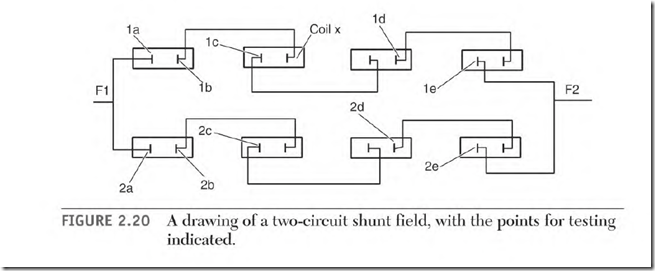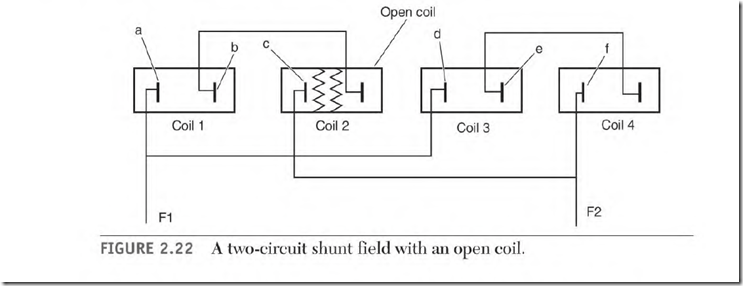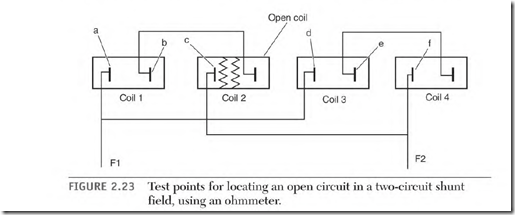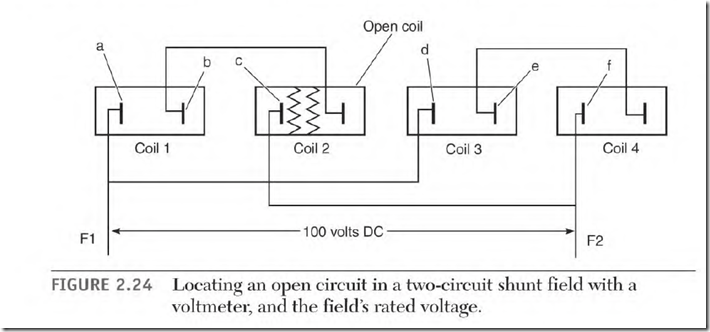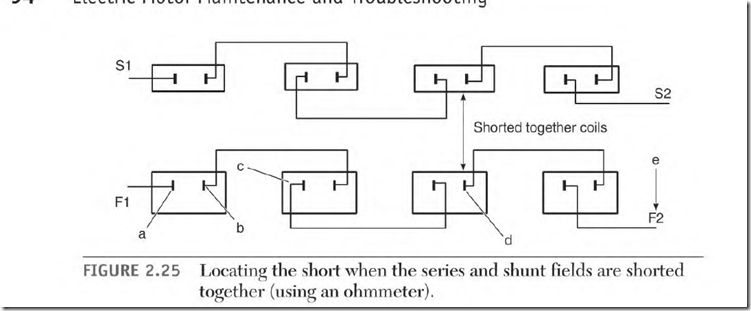The following symptoms indicate shorted turns in the shunt field:
• High amperes
• Shunt field coils hot
• Some or all brushes arc excessively
• A motor will have low starting torque and higher than normal no-load speed
• A generator will not develop full voltage and power when loaded
Locating a Shorted Shunt Field Coil Using an Ohmmeter
Be sure the power is disconnected and that one of the shunt field leads (Fl or F2) isn’t connected to the armature circuit. Record the ohmmeter reading across each coil. (There should be a difference of no more than +2 percent.)
Locating a Shorted Shunt Field Coil Using a Voltmeter
Apply nameplate-rated DC voltage to the shunt field (Fl and F2). If necessary, use a resistor to limit the amperes (to no more than 10 percent higher than shunt field nameplate amperes).
Divide the nameplate shunt field voltage by the number of coils in series to find the normal voltage across each coil. If all the coils are good, the voltage across each coil will be within 5 percent of each other.
A shorted coil will have lower voltage across it than the rest of the coils. When the shunt field’s rated voltage is applied, the difference between a shorted coil voltage and normal coil voltage is split among the rest of the coils. The voltage across each coil is increased (which raises the amperes and increases the heat).
Verifying That a Shunt Field Coil Is Shorted Using the Smoke Test
A coil that has a 4 or 5 percent lower ohmmeter reading than the rest may or may not have shorted turns. The smoke test will determine whether there are any. (This test won’t damage a coil that isn’t shorted.)
Open the coil’s connections and apply AC voltage to them. The voltage should be limited to the shunt field’s nameplate voltage. (TUrns within the short will get hot, indicating the coil needs to be replaced.)
If the machine has run (with high amperes and temperature) long enough to damage the coil insulation, all coils in the circuit should be replaced.
Locating a Shorted Coil in a Parallel Circuit Shunt Field with an Ohmmeter
Figure 2.20 shows this motor’s connection. Two shunt field circuits in parallel should have identical amperes. A circuit with higher amperes than the others will have a shorted coil(s).
When testing from a to b in Fig. 2.20, the ohmmeter will show less resistance than this coil has. (This is because of the loop circuit through the remaining coils in the parallel circuit.) Although the loop circuit’s resistance isn’t the resistance of the coil, this value can be compared with all coils in the two circuits. If there are no shorted coils, their values will be within 2 percent of each other.
Locating a Shorted Coil in a Parallel Circuit Using a Voltmeter
If a voltage drop test is used on the machine in Fig. 2.20, each coil should read within 5 percent of the others. Voltage across each coil in this example should be approximately one-fourth the applied voltage. If coil x has shorted turns, the voltage across the rest of the coils in this circuit will be higher than one-fourth the applied voltage. (All coils in this circuit should be replaced.) The following are open shunt field symptoms:
• Very little starting torque
• Overspeeding
• Brushes arc excessively
• High amperes in armature circuit at any speed
Shunt Field with an Open Circuit
The motor won’t start a load if the shunt field circuit is open. If it’s running when the open occurs, the control should shut it off immediately.
A loaded motor will try to overspeed. It will lose most of its countervoltage, and the amperes through the armature will become excessively high.
If there is no load the motor will accelerate until the armature is destroyed.
When test running an unloaded motor with a shunt field, be sure Fl and F2 are securely connected.
Locating an Open Circuit Using an Ohmmeter
The motor in this test has a one-circuit shunt field (Fig. 2.21). There is no ohmmeter reading between Fl and F2. Connect one ohmmeter lead securely to Fl. Pierce the insulation as shown in Fig. 2.21 at point #5. (This is on the coil side of the connection from lead F2.) If there is no reading, proceed to point 4, etc., until a reading is found.
If the open coil was shorted before it opened, all coils in the circuit have probably overheated. In this case, they should all be replaced.
The only exceptions to replacing all the coils are an open coil that has worn through the insulation (from being loose on the iron) or a coil that has been physically damaged.
Locating an Open in a Parallel Circuit Using an Ohmmeter
Figure 2.22 shows a two-circuit shunt field. With the nameplate information for the shunt field being 100 volts and 10 amperes, use the following procedure to determine the resistance of a shunt field coil:
100 volts — 10 amperes — 10 ohms (the resistance of the shunt field) 10 ohms x 2 circuits = 20 ohms per circuit
There are two coils per circuit:
20 ohms + 2 coils — 10 ohms per coil
A test from Fl to F2 would show 20 ohms. This is twice the shunt field’s normal resistance.
First, the connections should be checked carefully. A faulty connection will get hot, become charred, and eventually open completely.
In Fig. 2.23 points a, b, c, d, e, and f are internal connections between coils and leads.
If coil 2 is open, a test from a to b will show the resistance of coil I only (10 ohms). The same value would be found from d to e and from e to f.
Across open coil 2, b to c, the circuit would be through coils l, 3, and 4.
The result would be the resistance of three coils added together, or 30 ohms.
A high resistance reading would identify the open coil in a parallel connected shunt field.
Locating an Open in a Parallel Circuit Using a Voltmeter
The shunt field in Fig. 2.24 is rated 100 volts and 10 amps. Coil 2 is open. If 100 volts are applied to Fl and F2, it will draw 5 amperes, one-half the nameplate rating. Piercing the connections at point a and b with the voltmeter probes will show no voltage. Points d to e and e to f will read 50 volts, or one-half the applied voltage. Point b to point c will read full voltage, identifying the open coil.
Shunt Field Shorted to the Series Field Symptoms
The following symptoms indicate a shunt field shorted to the series field:
• High shunt field amperes
• Some hot shunt field coils
• Erratic speed
Locating Shunt Field Shorted to the
Series Field Using an Ohmmeter
Normally there are separate leads for accessing the armature and series field. When a machine is custom made for a definite load, the two circuits may have an internal connection that eliminates one of the shunt field leads.
Be sure the power is disconnected and disconnect the field leads. If there is no short, a test from Fl to Sl will read infinity.
Figure 2.25 illustrates a coil-to-coil short in coil 3. Connect one ohmmeter probe to Sl. With the other probe, pierce the shunt field connections at points a, b, c, d, and e. Points c and d will have the lowest readings, indicating the short is located in the coil between them.
A shunt and series field insulation breakdown is usually caused by burned insulation between the fields. The load amperes flow through the series field. An overload overheats the series field, deteriorating (and eventually destroying) the separating insulation. This problem requires rewinding all field coils>
